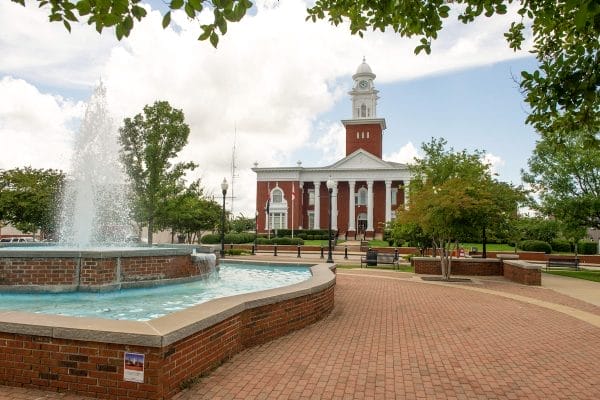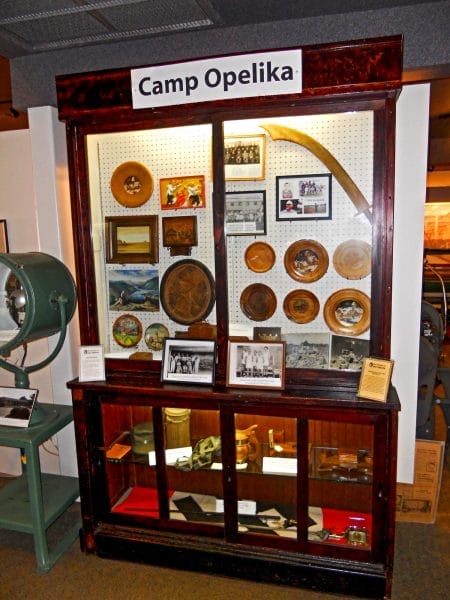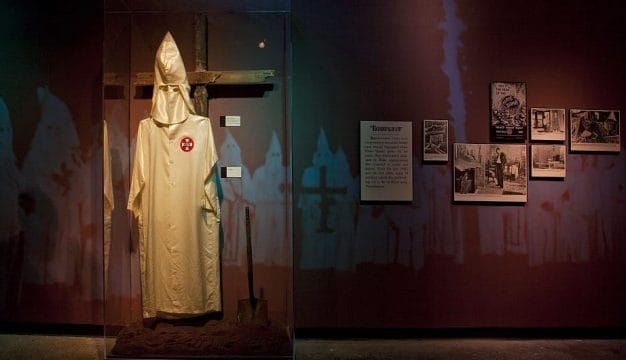Opelika
 Lee County Courthouse
The city of Opelika, known once as the Trading Center of East Alabama, is the county seat of Lee County. Opelika is situated at the juncture of the Piedmont Upland and East Gulf Coastal Plain physiographic sections. The town’s name means “big swamp” in the Muskoghean language spoken by the region’s Native Americans. Evolving from a small railroad town, Opelika is part of the sixth fastest-growing small metropolitan area in the nation. Opelika is governed by a mayor-council government, with a mayor and a five-member city council. Alabama governors Forrest “Fob” James and William J. Samford were both born in Opelika, as were Joe Beckwith, former Major League baseball pitcher with the 1985 World Series Champion Kansas City Royals; William Dickinson, U.S. congressman from 1965 to 1993; Roy Lee Jackson, former Major League baseball player; and Erick Strickland, former National Basketball Association player. Astronaut James Voss spent the majority of his childhood in the town, as did visual artist Roger Brown.
Lee County Courthouse
The city of Opelika, known once as the Trading Center of East Alabama, is the county seat of Lee County. Opelika is situated at the juncture of the Piedmont Upland and East Gulf Coastal Plain physiographic sections. The town’s name means “big swamp” in the Muskoghean language spoken by the region’s Native Americans. Evolving from a small railroad town, Opelika is part of the sixth fastest-growing small metropolitan area in the nation. Opelika is governed by a mayor-council government, with a mayor and a five-member city council. Alabama governors Forrest “Fob” James and William J. Samford were both born in Opelika, as were Joe Beckwith, former Major League baseball pitcher with the 1985 World Series Champion Kansas City Royals; William Dickinson, U.S. congressman from 1965 to 1993; Roy Lee Jackson, former Major League baseball player; and Erick Strickland, former National Basketball Association player. Astronaut James Voss spent the majority of his childhood in the town, as did visual artist Roger Brown.
History
 Darden House in Opelika
The first white settlers arrived in the area now known as Opelika in the late 1830s, after the Creek Indians ceded the land to the U.S. government in the 1832 Treaty of Cusseta. In 1848, the Montgomery & West Point Railroad Company completed a rail line from Montgomery to Opelika, then located in Russell County and extended one to West Point, Georgia, three years later. This second line connected Opelika with Atlanta, Georgia, and was the only direct rail route between New Orleans and the Eastern Seaboard at the time, becoming one of the main trade lines for shipping unprocessed cotton from southern plantations to the North.
Darden House in Opelika
The first white settlers arrived in the area now known as Opelika in the late 1830s, after the Creek Indians ceded the land to the U.S. government in the 1832 Treaty of Cusseta. In 1848, the Montgomery & West Point Railroad Company completed a rail line from Montgomery to Opelika, then located in Russell County and extended one to West Point, Georgia, three years later. This second line connected Opelika with Atlanta, Georgia, and was the only direct rail route between New Orleans and the Eastern Seaboard at the time, becoming one of the main trade lines for shipping unprocessed cotton from southern plantations to the North.
Railroads spurred rapid growth in Opelika, and it officially was chartered as a town on February 9, 1854. An additional rail line was added from Opelika to Columbus, Georgia, in 1855. These rail lines were destroyed, along with depots and warehouses full of supplies for Confederate forces defending Atlanta, when Union general Lovell Rousseau led a raid into east-central Alabama in mid-July 1864. After the Civil War ended, the city was in desperate need of rebuilding. The Alabama State Legislature created a new county out of parts of Macon, Russell, Chambers, and Tallapoosa counties, naming it after Confederate general Robert E. Lee. In 1866, citizens of the new Lee County voted Opelika as the new county seat. The town’s first courthouse, replaced in 1897 with the present courthouse, was designed by renowned African American builder Horace King.
In 1868, an accidental fire destroyed most of Opelika’s business district, catapulting Opelika into a chaotic period. The municipal government was unsuccessful in trying to fix the financial problems and political infighting that arose after Reconstruction ended in 1870. Finally, Gov. Edward O’Neal had to deploy the state militia to Opelika in order to restore order.
Economic Development
 Pepperell Mill in Opelika, ca. 1933
Opelika expanded in the second half of the nineteenth century. Residents built an opera house and funded the installation of brick streets. In 1896, Opelika became one of 10 experimental sites for the postal service’s new rural free delivery program. In 1900, local investors established the Opelika Cotton Mill as the first textile plant in the city, employing 125 workers. The mill stayed in business until the close of the twentieth century and is best known today, along with its surrounding mill village and the Golden Cherry Motel, as filming locations for the 1979 film Norma Rae. In 1914, a training school for nurses was established at the local hospital, operating for 18 years before being closed in 1931. By the 1920s, Opelika had 24 daily passenger trains stopping in the town. In 1925, the Pepperell Manufacturing Company (later WestPoint Home) was established and flourished until its closing in 2006. No textile mills remain open in the city.
Pepperell Mill in Opelika, ca. 1933
Opelika expanded in the second half of the nineteenth century. Residents built an opera house and funded the installation of brick streets. In 1896, Opelika became one of 10 experimental sites for the postal service’s new rural free delivery program. In 1900, local investors established the Opelika Cotton Mill as the first textile plant in the city, employing 125 workers. The mill stayed in business until the close of the twentieth century and is best known today, along with its surrounding mill village and the Golden Cherry Motel, as filming locations for the 1979 film Norma Rae. In 1914, a training school for nurses was established at the local hospital, operating for 18 years before being closed in 1931. By the 1920s, Opelika had 24 daily passenger trains stopping in the town. In 1925, the Pepperell Manufacturing Company (later WestPoint Home) was established and flourished until its closing in 2006. No textile mills remain open in the city.
 Camp Opelika Museum Exhibit
During World War II, the U.S. Army constructed a prisoner-of-war camp in Opelika. Variously called Camp Opelika, the Opelika Internment Camp, and the Opelika PW Camp, the facility officially opened on December 12, 1942, and eventually housed more than 2,700 prisoners; it closed on December 8, 1945. From 1950 to 1975, the major industries that funded Opelika’s economy were linen, magnetic tape at a factory founded by John Herbert Orr, auto tires, sheet-metal and iron-fabricating plants, bottling companies, bakeries, and publishing, textile, and hospital facilities. In 1963, Uniroyal built a tire plant in the city, and Diversified Products, an exercise-equipment manufacturer founded in part by future governor Fob James, opened a facility. James’s company closed in 1989 and the tire plant, under the ownership of Michelin USA, closed in October 2009. In 2007, new industry accounted for almost 1,500 jobs and more than $321 million in capital investment. The city’s most recent retail development, Tiger Town, was completed in 2005. With more than 750,000 square feet of retail shopping, Tiger Town is the largest retail center in East Alabama.
Camp Opelika Museum Exhibit
During World War II, the U.S. Army constructed a prisoner-of-war camp in Opelika. Variously called Camp Opelika, the Opelika Internment Camp, and the Opelika PW Camp, the facility officially opened on December 12, 1942, and eventually housed more than 2,700 prisoners; it closed on December 8, 1945. From 1950 to 1975, the major industries that funded Opelika’s economy were linen, magnetic tape at a factory founded by John Herbert Orr, auto tires, sheet-metal and iron-fabricating plants, bottling companies, bakeries, and publishing, textile, and hospital facilities. In 1963, Uniroyal built a tire plant in the city, and Diversified Products, an exercise-equipment manufacturer founded in part by future governor Fob James, opened a facility. James’s company closed in 1989 and the tire plant, under the ownership of Michelin USA, closed in October 2009. In 2007, new industry accounted for almost 1,500 jobs and more than $321 million in capital investment. The city’s most recent retail development, Tiger Town, was completed in 2005. With more than 750,000 square feet of retail shopping, Tiger Town is the largest retail center in East Alabama.
Demographics
According to 2020 Census estimates, the population of the city of Opelika was 30,589. Of that number, 53.3 percent reported themselves as white, 41.3 percent as African American, 4.8 percent as Hispanic or Latino, 3.3 percent as Asian, 1.7 as two or more races, and 0.1 percent as American Indian and Alaska Native. The median household income was $50,488, and the per capita income was $26,961.
Employment
According to 2020 Census estimates, the workforce in Opelika was divided among the following industrial categories:
- Educational services, and health care and social assistance (32.5 percent)
- Manufacturing (14.8 percent)
- Retail trade (12.9 percent)
- Arts, entertainment, recreation, accommodation, and food services (11.8 percent)
- Professional, scientific, management, and administrative and waste management services (9.1 percent)
- Finance, insurance, and real estate, rental, and leasing (5.1 percent)
- Construction (3.3 percent)
- Public administration (3.3 percent)
- Other services, except public administration (2.5 percent)
- Transportation and warehousing and utilities (1.8 percent)
- Information (1.6 percent)
- Wholesale trade (1.0 percent)
- Agriculture, forestry, fishing and hunting, and extractive (0.4 percent)
Education
The Opelika City School System has three elementary schools, three intermediate schools, one middle school, and one high school, as well as the vocational Opelika Learning Center. Opelika is also home to a branch of Southern Union State Community College, a two-year community and technical college offering academic, industrial, and health-sciences training.
Transportation
Opelika is served by three main routes: U.S. 29/I-85, which runs southeast-northwest along the southern end of the city; U.S. 280, which runs north-south; and U.S. 431, which runs north on the eastern edge of the city. Norfolk Southern Corporation and Georgia Southwestern Railroad operate the railroad traffic through Opelika.
Events and Places of Interest
 Grand National Golf Course in Opelika
The Grand National golf complex, part of Alabama’s Robert Trent Jones Golf Trail, is located in Opelika and is listed in the top ten of Golf Digest‘s “America’s Top 50 Affordable Golf Courses”; it has a conference center and resort hotel. Opelika also hosts the annual Dogwood and Azalea Trail and the Victorian Front Porch Christmas Tour, and is home to the Museum of East Alabama and Historic Downtown Opelika, listed on the National Register of Historic Places. Opelika Municipal Park offers visitors rides on a miniature train, an annual concert series, and the Salem-Shotwell Covered Bridge, which is a restored section of a historic structure that once spanned Wacoochee Creek in Salem, Lee County.
Grand National Golf Course in Opelika
The Grand National golf complex, part of Alabama’s Robert Trent Jones Golf Trail, is located in Opelika and is listed in the top ten of Golf Digest‘s “America’s Top 50 Affordable Golf Courses”; it has a conference center and resort hotel. Opelika also hosts the annual Dogwood and Azalea Trail and the Victorian Front Porch Christmas Tour, and is home to the Museum of East Alabama and Historic Downtown Opelika, listed on the National Register of Historic Places. Opelika Municipal Park offers visitors rides on a miniature train, an annual concert series, and the Salem-Shotwell Covered Bridge, which is a restored section of a historic structure that once spanned Wacoochee Creek in Salem, Lee County.
Further Reading
- The Heritage of Lee County, Alabama. Clanton, Ala.: Heritage Publishing Consultants, 2000.



